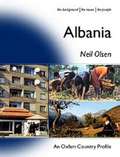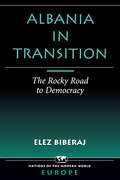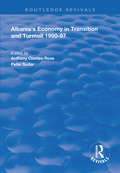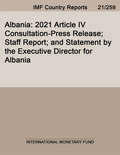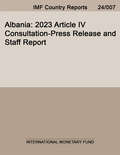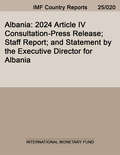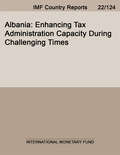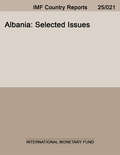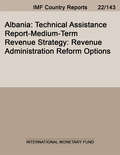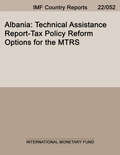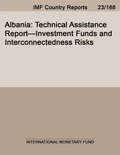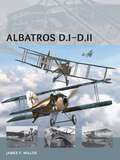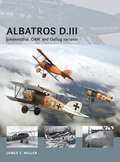- Table View
- List View
Albania
by Neil OlsenThe Albania Country Profile skillfully unravels the historical and political background to the present situation in Albania. Despite the advent of democracy in 1992, Albanians have found it hard to participate fully in the building of a new society. The volatility of regional politics in the Balkans, and the absence of a democratic culture, have hindered economic and social progress. Much of this Country Profile is told in the voices of Albanians themselves: people imprisoned under the communist regime of Enver Hoxha; students who took part in political protests in the 1990s; villagers who have held on to traditional identities, and women active in setting up social-action groups.
Albania In Transition: The Rocky Road To Democracy
by Elez BiberajThis book focuses on the trials and tribulations of Albania's efforts to create a democratic political order. It assesses the degree and significance of changes since the early 1990s, providing a detailed account of the transition from Communist Party rule to multiparty competition.
Albania's Economy in Transition and Turmoil 1990-97 (Routledge Revivals)
by Petar Sudar Anthony Clunies-RossFirst published in 1998, the contents of this book is the result of a series of studies by several Albanian scholars, in cooperation with contributors of differing nationalities, on various aspects of the Albanian economy during its ‘transition to market’. This study’s multiple aim is to provide an accessible body of information for outsiders interested in Albania ; to provide locally based teaching material for Albanian economics students; and to also clarify policy issues.
Albania: 2021 Article IV Consultation-Press Release; Staff Report; and Statement by the Executive Director for Albania
by International Monetary Fund. European Dept.A report from the International Monetary Fund.
Albania: 2022 Article Iv Consultation-press Release; Staff Report; And Statement By The Executive Director For Albania (Imf Staff Country Reports)
by International Monetary Fund. European Dept.A report from the International Monetary Fund.
Albania: 2023 Article Iv Consultation-press Release And Staff Report (Imf Staff Country Reports)
by International Monetary Fund. European Dept.A report from the International Monetary Fund.
Albania: 2024 Article IV Consultation-Press Release; Staff Report; and Statement by the Executive Director for Albania
by International Monetary Fund. European Dept.A report from the International Monetary Fund.
Albania: Enhancing Tax Administration Capacity During Challenging Times (Imf Staff Country Reports)
by International Monetary Fund. Fiscal Affairs Dept.A report from the International Monetary Fund.
Albania: Ex Post Assessment of Longer-Term Program Engagement
by International Monetary FundFinancial report from the IMF
Albania: Fourth Review Under the Three-Year Arrangement Under the Poverty Reduction and Growth Facility, Request for a Waiver of Nonobservance of Performance Criterion, and Financing Assurances Review--Staff Report; Press Release on the Executive Board Discussion; and Statement by the Executive Director for Albania
by International Monetary FundA report from the International Monetary Fund.
Albania: From Isolation Toward Reform
by Mario I. Blejer Mauro Mecagni Ratna Sahay Richard Hides R. Barry Johnston Piroska Nagy Roy PepperFinancial report from the IMF
Albania: Report on the Observance of Standards and Codes--Data Module, Response by the Authorities, and Detailed Assessments Using the Data Quality Assessment Framework
by Michael Deppler Robert W. EdwardsFinancial report from the IMF
Albania: Second Review Under the Three-Year Arrangement Under the Poverty Reduction and Growth Facility--Staff Report; Staff Statement; Press Release on the Executive Board Discussion; and Statement by the Executive Director for Albania
by International Monetary FundFinancial report from the IMF
Albania: Selected Issues
by International Monetary Fund. European Dept.A report from the International Monetary Fund.
Albania: Selected Issues (Imf Staff Country Reports)
by International Monetary Fund. European Dept.A report from the International Monetary Fund.
Albania: Selected Issues and Statistical Appendix
by International Monetary FundIn recent years, the IMF has released a growing number of reports and other documents covering economic and financial developments and trends in member countries. Each report, prepared by a staff team after discussions with government officials, is published at the option of the member country.
Albania: Selected Issues and Statistical Appendix
by International Monetary FundA report from the International Monetary Fund.
Albania: Sixth Review Under the Extended Arrangement Under the Poverty Reduction and Growth Facility, Request for a Waiver of Nonobservance of Performance Criterion, and Financing Assurances Review--Staff Report; Supplementary Information; and Press Release on the Executive Board Consideration
by International Monetary FundA report from the International Monetary Fund.
Albania: Technical Assistance Report-Medium-Term Revenue Strategy: Revenue Administration Reform Options (Imf Staff Country Reports)
by International Monetary Fund. Fiscal Affairs Dept.A report from the International Monetary Fund.
Albania: Technical Assistance Report-Tax Policy Reform Options for the MTRS (Imf Staff Country Reports)
by Dora Benedek, Aqib Aslam, and Narine NersesyanA report from the International Monetary Fund.
Albania: Technical Assistance Report—Investment Funds and Interconnectedness Risks
by International Monetary Fund. Monetary and Capital Markets DepartmentA report from the International Monetary Fund.
Albany Beach Murders Boxed Set: Romance Psychological Suspense (The Albany Beach Murders)
by Hunter Morgan"Get ready for top-notch excitement that is just the beginning of a must-have, must-read trilogy." ~Suzanne ColeburnA Delaware Beach Serial Killer Sets His Sights on the Ultimate Prize in the Award-Winning Thriller Trilogy, Albany Beach Murders, by Hunter MorganShe'll Never Tell: Following a car crash, a coma, and reconstructive surgery that transformed her into the woman she always wanted to be, Marcy Edmond discovers that her twin, Phoebe, has moved into her home, stolen the hearts of her children—and possibly her husband. Worse, Marcy has become the kind of beautiful swan he prefers ... to kill.She'll Never Know: A victim of amnesia, all Jillian Deere knows is that she had a gunshot wound to her neck and was left by an unidentified man at a hospital. Drawn to Albany, Jillian is certain someone is watching her, someone who knows exactly who she is … his next victim.She'll Never Live: Her days are numbered ... by a sadistic madman known as the Bloodsucker. All summer, he's preyed on the women of Albany Beach and now, business is down, suspicion is up, fear runs rampant, and police chief Claire Drummond has her work cut out for her. Meanwhile, the Bloodsucker continues spinning his web, his sights set on the ultimate prize.Publisher Note: The Albany Beach Murders Trilogy contains three complete stories with one blood thirsty killer. There is some sexual content and mild profanity, neither of which is sensationalized. These are three great thrillers sure to be enjoyed by fans of John Sanford, Brianna Labuskes, Leslie Wolfe and Rachel Caine, author of the Still House Lake series. Readers who like a straight-up thriller without overdone sex and vulgarity will appreciate this trilogy.Awards: Delaware Diamond Award for Literary Excellence, P.E.A.R.L. Award Meet Hunter Morgan:Hunter Morgan has been writing and publishing books under various pseudonyms, in different genres for thirty years. The author of romance, mystery, suspense and women's fiction books, she's published world-wide and in multiple languages.
Albany: Birth of a Prison – End of an Era (Routledge Library Editions: Prison and Prisoners)
by Roy D. King Kenneth W. ElliottOriginally published in 1977, Albany: Birth of a Prison - End of an Era attempts to document and analyse some of the changes which happened in the first five and a half years of the prison’s opening and as far as possible account for them. Albany was planned and built as a medium-security establishment but the growth in the prison population meant it ended up, in part, as a maximum-security unit. At the time the prison was notorious, after a stormy series of incidents culminated in an alleged mass escape attempt and a riot, it had become known as the ‘jail of fear’ in which ‘mafia groups’ were said to ‘terrorize’ staff and prisoners alike. Despite the account inevitably being incomplete, it was hoped that lessons could be drawn, both for social research and social policy in regard to prisons.
Albatros D.I-D.II
by James MillerIn 1916 German aerial domination had been lost to the French and British fighters. German fighter pilots requested an aircraft that was more powerful and more heavily armed, and the Albatros design bureau set to work on what was to become an iconic aircraft design. By April 1916, they had developed the Albatros D.I, that featured the usual Albatros semi-monocoque wooden construction with a 160hp Mercedes engine and two forward-firing machine guns. Alongside the development of the D.I, Albatros had also designed and built a second machine that was similar to the D.I - the Albatros D.II. Although there were several external differences between the two aircraft, it is important to note that these machines evolved simultaneously and that the D.II was not the result of post-combat feedback from D.I pilots. With the inclusion of these aircraft into their reorganized air force, Germany was able to regain control of the skies by autumn 1916. Along with the later designs they inspired, the Albatros D.I and D.II were instrumental in allowing the Germans to prosecute their domination through 'Bloody April' and well into the summer months that followed.
Albatros D.III
by James MillerIn 1916, Imperial German aerial domination, once held by rotary-engined Fokker and Pfalz E-type wing-warping monoplanes, had been lost to the more nimble French Nieuport and British DH 2s which not only out-flew the German fighters but were present in greater numbers. Born-from-experience calls from German fighter pilots requested that, rather than compete with the maneuverability of these adversaries, new single-engine machines should be equipped with higher horsepower engines and armed with two, rather than the then-standard single machine guns. The Robert Thelen-led Albatros design bureau set to work on what became the Albatros D.I and D.II and by April 1916 they had developed a sleek yet rugged machine that featured the usual Albatros semi-monocoque wooden construction and employed a 160hp Mercedes D.III engine with power enough to equip the aeroplane with two forward-firing machine guns. Visual hallmarks of the D.I and early production D.II include fuselage mounted Windhoff radiators and matching chords for the upper and lower wings. Meanwhile, Albatros had already produced the prototype of the D.II's successor, the D.III. Influenced by the French Nieuport sesquiplane design, the D.III featured lower wings of reduced chord and single-spar construction, with the interplane struts now meeting the lower wings in a 'V'. After arriving at the Front en masse in early 1917, the Royal Flying Corps did not possess a fighter that could arrest the Albatros' onslaught against the RFC reconnaissance machines and thus they suffered appalling casualties in a desperate period known as 'Bloody April'. However, despite the D.III's success, the sesquiplane design led to structural flaws that resulted in the deaths of several pilots, which caused the type to be grounded until the lower wings could be strengthened or replaced. Still, even after their return to service, German pilots knew not to prosecute a dive too aggressively lest they invite structural catastrophe.Always chasing performance enhancements, by the time of 'Bloody April' Albatros had already designed and received a production order for the D.V.D.IIIs were manufactured concurrently but production was shifted to the Ostdeutsche Albatros Werke (OAW) in Schneidmuhl, where they received more robust construction. They differed little from their Johannisthal D.III brethren externally, save for a slightly different skin application on the nose and a D.V-type rudder, which had a curved rather than straight trailing edge. They also had Mercedes engines of 175 hp, versus the 160 hp engines of the Johannisthal D.III. Overall they benefitted from the teething experience of the earlier D.IIIs and avoided the structural problems that resurfaced with the Johannisthal-built D.Vs. In all, 500 D.IIIs and 840 D.III(OAW)s were produced and saw heavy service throughout 1917. They extracted a serious toll on the enemy but as the year progressed faced an increasing number of new enemy fighter types, including the Sopwith Pup, Sopwith Triplane, SPAD VII, and SE5a, but remained at the Front in high numbers (446 of both types were recorded on 31 October) until dwindling in spring 1918 (from 357 in February to 82 in June) with the arrival of the Fokker Dr.I and D.VII.
